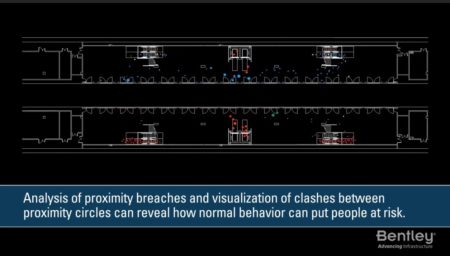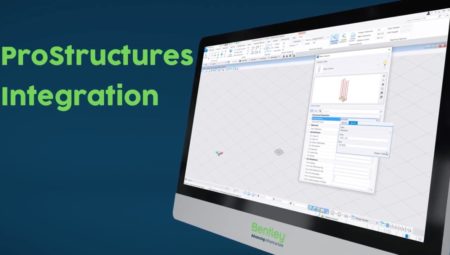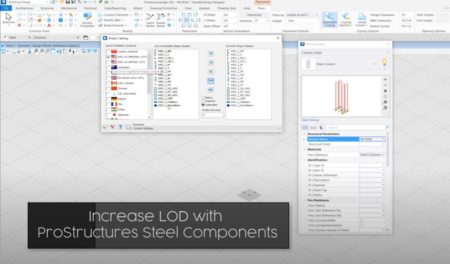Continued from page 1
Bentley and Architecture
During Bentley’s conference, I had a virtual meeting with Susanne Trierscheid, who is a senior director at Bentley (and educated as an architect in Germany) and is now the lead person for all the “vertical modeling” tools (including OpenBuildings products and all similar products around Plants and all the structural detailing engineering tools); I also spoke with Eduardo Lazzarotto who is the product manager for all the “building” modeling tools, of which the most prolific tool is OpenBuildings.
We believe that this is a good opening for us to tackle that again with the architects.
One of the things I brought up in this conversation with Susanne Trierscheid and Eduardo Lazzarotto was my discussion with Elaine Lewis of Cadventure in the UK. I told them that I was surprised to learn from that conversation that many of the firms who signed the Revit Open Letter were at one point (five or more years ago) on the Bentley platform. I asked Trierscheid if Bentley was now, in light of the Revit Open Letter, recognizing new opportunities for them back in the world of Architecture.
She answered in the affirmative, saying, “we believe that this is a good opening for us to tackle that again with the architects.” “We talk to Cadventure a lot, and we know each other well,” she said. “And of course, we listen to their messaging because they talk to a lot of users. So we believe that at the moment, the opening is very good.”
While it has appeared that Bentley has backed away from the architecture market, Trierscheid explained that Revit’s dominance in common sized firms, which range from very small to medium to very large made it more logical for Bentley to retarget where they would market their building solutions. But things are changing for them now due to a confluence of inputs, and the Revit Open Letter was just another one highlighting some factors. For example, a major complaint of the UK firms who signed the letter had to do with performance and commitment to interoperability and open standards.
I think we are going to really go after the larger projects and tackle this whole collaboration angle, as well as the modeling because that is also where we are really strong.
Bentley knows from their own award program that their Microstation-based products like OpenBuildings Designer can handle massive projects on the performance front. This is why it has been successful in large infrastructure, whether that infrastructure is vertical or horizontal. “So we need to focus on the larger practices,” said Trierscheid. “They need to feel our rekindling of focus on building and modeling again.”
“I think we are going to really go after the larger projects and tackle this whole collaboration angle,” said Trierscheid, “as well as the modeling because that is also where we are really strong. ” For those who are not aware, Bentley’s Microstation-based technologies tap the power of the Parasolid modeling kernel, the world’s most advanced 3D modeling engine.

Bentley’s OpenBuildings Station Designer features LEGION for pedestrian simulation which can now factor in social distancing criteria into its operations. LEGION can actually be used on any building type where social distancing simulation may be important. (Image: Bentley)
OpenBuildings Designer has a sibling product called OpenBuildings Station Designer to address rail and transit station design. It features industry-leading pedestrian simulation technology, which can now address social distancing and other pandemic response design. (see above). This is a sub-sector focus backed up with specialized tools for this sector.
Trierscheid also noted that OpenBuildings Designer could focus on sub-sectors like manufacturing and large campuses, in addition to architecture related to rail stations. With the former, Bentley’s GenerativeComponents (GC) algorithms-aided design (AAD) technologies can address layout optimization inside factories. GC and OpenBuildings Designer (OBD) core strengths in modeling also make it highly suitable for buildings with complex forms. While a lot of this work is now done in Rhino with Grasshopper, OBD can reference Rhino files. A smarter move might be to tap the Rhino.Inside API and enable Rhino and Grasshopper directly inside OpenBuildings Designer. Such a move might seem to conflict with Bentley’s own GenerativeComponents. Still, I would contend such thinking led to the hesitation of integrating third-party renderers in leading BIM programs, but today the more rendering tools you can tap into, the better and more flexible the BIM solution is to users.

ProStructures is now integrated into OpenBuildings Designer, Update 7. This can help increase LOD in BIM models. (Image: Bentley)
It is time all BIM platforms start recognizing that generative design or AAD tools from third-parties need pathways into these BIM solutions, even if those BIM solutions feature home-grown AAD technologies. The mantra in the market is “agility,” and the democratization of tools aids that agility. Bentley should take its GC technology and build-out “ready-to-go” computational design workflows that buttress and support targeting sub-sectors of the building and campuses market. Tools for large, expansive complex roofs typical of airports and large rail hubs could be dovetailed within OBD and Bentley’s structural analysis tools, for example. GC technology can be customized for optimized layout design in factories and manufacturing, as Trierscheid suggested. Those efforts are not mutually incompatible with allowing Rhino.Inside into OpenBuildings Designer (OBD). Allowing Rhino and Grasshopper functionality directly inside OBD gives OBD instant access to a large ecosystem of AAD specialized toolsets.
OpenBuildings Designer—Today
Lazzarotto ran through the latest version of OpenBuildings Designer (Update 7). It was released a few months back. A big new feature is integrating OBD’s structural elements with Bentley’s ProStructures, a software used for structural detailing. “What this means said Lazzarotto, is that the architects or engineers can now detail some parts of their project to a much higher level of development for their project, and it makes it a lot easier for them to integrate with products like STADD and RAM for structural analysis.”

ProStructures is now integrated into OpenBuildings Designer, Update 7. This can help increase LOD in BIM models. (Image: Bentley)
They also integrated Bentley’s separate product Hevacomp Dynamic Simulation into the latest release of OBD. “What we did is convert that tool into what we now call OpenBuildings Energy Simulator,” said Lazzarotto. Bentley also offered two language versions of OpenBuildings Designer, targeting the Czech Republic and Russia’s growing markets. “Russia is a growing market for us, not only for OBD but for a range of Bentley products like OpenRoads, OpenRail, and so forth,” he added.
Update 7 also addressed major fixes and added new features, like improvements to the stair tool and also curtain walls, which are relatively a new feature in OBD.
OpenBuildings Designer—Future
Without getting into specifics, Lazzarotto said that GenerativeComponents (GC) was now a technology at Bentley and that Update 8 for OpenBuildings Designer will tap more of this AAD functionality. Providing a clue, both OpenRail and OpenRoads tap the power of GC now. “What we are doing is treating GC as a technology rather than a product…and we are investing in the technology itself and the functionality and capability of that technology,” he added.
We name our products ‘Open’ because we want them to be interoperable with other applications in the market.
In asking about the future of API integrations with OBD, Lazzarotto said it was a great question. “We name our products ‘Open’ because we want them to be interoperable with other applications in the market. All of our digital twin apps are actually open-source code. iModel.js is actually open for any developer who wants to build solutions on top of it,” he said.
Another issue that came up in the Revit Open Letter was standards. Lazzarotto said that they are working to align their data sets to ISO 19650. “That is something we will definitely want to talk about early next year with our next release,” he said. Bentley is also still investing a lot with buildingSMART given IFC 4, Reference View. He added that it is more than just the architectural side but the structural side as well. “Of course, the whole idea of Reference View is that users can make their data portable and take that data into other applications and add value to those applications.”
Closing Commentary
Bentley looks to be acknowledging the importance of convergence in our world. By building out solution stacks (combinations of apps that work together in well-honed workflows) built specifically for “vertical infrastructure” related to the “horizontal infrastructure” where the company is a market leader, you end up with offerings like OpenBuildings Station Designer. This product’s unique selling point (USP)—a topic in itself we covered in our last Xpresso issue—is its ability to simulate a station’s usage and operations and predict real-world performance. With COVID-19 now a part of simulation criteria, it was not surprising to learn that LEGION’s latest updates could handle new social distancing simulation.
Could there be more OpenBuildings-branded product suites to come? Susanne Trierscheid noted that it might not make sense for Bentley to compete against BIM tools like Revit that are aimed at the whole of the entire architecture market. Specializing on large buildings, buildings tied to horizontal infrastructure, campuses, and manufacturing seems like a strategy that will enable Bentley to offer deeper capabilities and unique selling points (USPs) that separate them from the crowded BIM market.
Did you enjoy this?
If you enjoyed this article and content like this, subscribe to our monthly email newsletter for FREE. You may also enjoy our INSIDER Reports series.




Reader Comments
[…] subsequent web page: Bentley and Architecture […]
Comments are closed.